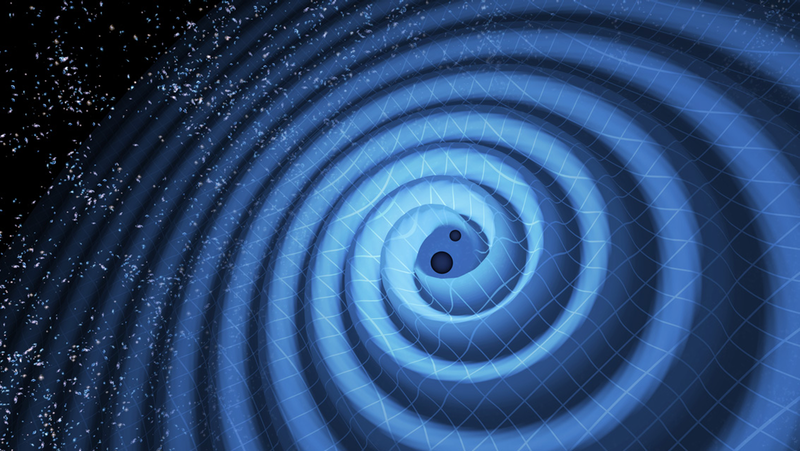Authors: KamLAND Collaboration
Reference: arXiv:1606.07155
After the chirp heard ‘round the world, the search is on for coincident astrophysical particle events to provide insight into the source and nature of the era-defining gravitational wave events detected by the LIGO Scientific Collaboration in late 2015.
By combining information from gravitational wave (GW) events with the detection of astrophysical neutrinos and electromagnetic signatures such as gamma-ray bursts, physicists and astronomers are poised to draw back the curtain on the dynamics of astrophysical phenomena, and we’re surely in for some surprises.
The first recorded gravitational wave event, GW150914, was likely a merger of two black holes which took place more than one billion light years from the Earth. The event’s name marks the day it was observed by the Advanced Laser Interferometer Gravitational-wave Observatory (LIGO), September 14th, 2015. LIGO detections are named “GW” for “gravitational wave,” followed by the observation date in YYMMDD format. The second event, GW151226 (December 26th, 2015) was likely another merger of two black holes, having 8 and 14 times the mass of the sun, taking place 1.4 billion light years away from Earth. A third gravitational wave event candidate, LVT151012, a possible black hole merger which occurred on October 12th, 2015, did not reach the same detection significance a the aforementioned events, but still has a >50% chance of astrophysical origin. LIGO candidates are named differently than detections. The names start with “LVT” for “LIGO-Virgo Trigger,” but are followed by the observation date in the same YYMMDD format. The different name indicates that the event was not significant enough to be called a gravitational wave.

The following computer simulation created by the multi-university SXS (Simulating eXtreme Spacetimes) project depicts what the collision of two black holes would look like if we could get close enough to the merger. It was created by solving equations from Albert Einstein’s general theory of relativity using the LIGO data. (Source: LIGO Lab Caltech : MIT).
Observations from other scientific collaborations can search for particles associated with these gravitational waves. The combined information from the gravitational wave and particle detections could identify the origin of these gravitational wave events. For example, some violent astrophysical phenomena emit not only gravitational waves, but also high-energy neutrinos. Conversely, there is currently no known mechanism for the production of either neutrinos or electromagnetic waves in a black hole merger.
Black holes with rapidly accreting disks can be the origin of gamma-ray bursts and neutrino signals, but these disks are not expected to be present during mergers like the ones detected by LIGO. For this reason, it was surprising when the Fermi Gamma-ray Space Telescope reported a coincident gamma-ray burst occurring 0.4 seconds after the September GW event with a false alarm probability of 1 in 455. Although there is some debate in the community about whether or not this observation is to be believed, the observation motivates a multi-messenger analysis including the hunt for associated astrophysical neutrinos at all energies.
Could a neutrino experiment like KamLAND find low energy antineutrino events coincident with the GW events, even when higher energy searches by IceCube and ANTARES did not?

KamLAND, the Kamioka Liquid scintillator Anti-Neutrino Detector, is located under Mt. Ikenoyama, Japan, buried beneath the equivalent of 2,700 meters of water. It consists of an 18 meter diameter stainless steel sphere, the inside of which is covered with photomultiplier tubes, surrounding an EVOH/nylon balloon enclosed by pure mineral oil. Inside the balloon resides 1 kton of highly purified liquid scintillator. Outside the stainless steel sphere is a cylindrical 3.2 kton water-Cherenkov detector that provides shielding and enables cosmic ray muon identification.
KamLAND is optimized to search for ~MeV neutrinos and antineutrinos. The detection of the gamma ray burst by the Fermi telescope suggests that the detected black hole merger might have retained its accretion disk, and the spectrum of accretion disk neutrinos around a single black hole is expected to peak around 10 MeV, so KamLAND searched for correlations between the LIGO GW events and ~10 MeV electron antineutrino events occurring within a 500 second window of the merger events. Researchers focused on the detection of electron antineutrinos through the inverse beta decay reaction.
No events were found within the target window of any gravitational wave event, and any adjacent event was consistent with background. KamLAND researchers used this information to determine a monochromatic fluence (time integrated flux) upper limit, as well as an upper limit on source luminosity for each gravitational wave event, which places a bound on the total energy released as low energy neutrinos during the merger events and candidate event. The lack of detected concurrent inverse beta decay events supports the conclusion that GW150914 was a black hole merger, and not another astrophysical event such as a core-collapse supernova.
More information would need to be obtained to explain the gamma ray burst observed by the Fermi telescope, and work to improve future measurements is ongoing. Large uncertainties in the origin region of gamma ray bursts observed by the Fermi telescope will be reduced, and the localization of GW events will be improved, most drastically so by the addition of a third LIGO detector (LIGO India).
As Advanced LIGO continues its operation, there will likely be many more chances for KamLAND and other neutrino experiments to search for coincidence neutrinos. Multi-messenger astronomy has only just begun to shed light on the nature of black holes, supernovae, mergers, and other exciting astrophysical phenomena — and the future looks bright.
Background reading:
- Review of neutrino astrophysics by W. C. Haxton: arXiv:1209.3743
- A collection of articles on gravitational waves from APS Physics
- A discussion of the GW events from the LIGO Scientific Collaboration
Eve Vavagiakis
Latest posts by Eve Vavagiakis (see all)
- Are you smarter than an ATLAS algorithm? - November 21, 2016
- Horton Hears a Sterile Neutrino? - September 19, 2016
- The CMB sheds light on galaxy clusters: Observing the kSZ signal with ACT and BOSS - August 17, 2016
